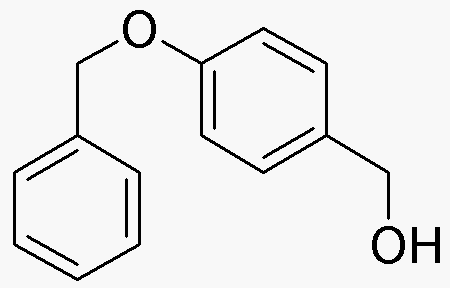4-Benzyloxybenzyl alcohol is widely utilized in research focused on:
- Synthesis of Pharmaceutical Compounds: This chemical serves as a key intermediate in the synthesis of various pharmaceuticals, enhancing the efficiency of drug development processes.
- Organic Synthesis: It is commonly used in organic chemistry for the preparation of complex molecules, allowing researchers to create new compounds with desirable properties.
- Material Science: In the development of polymers and resins, it acts as a functional additive, improving the mechanical and thermal properties of materials.
- Cosmetic Formulations: The compound is included in cosmetic products for its potential as a stabilizer and fragrance component, contributing to product longevity and user experience.
- Research in Chemical Biology: It is utilized in studies exploring enzyme interactions and cellular processes, providing insights into biological mechanisms and potential therapeutic targets.
General Information
Properties
Safety and Regulations
Applications
4-Benzyloxybenzyl alcohol is widely utilized in research focused on:
- Synthesis of Pharmaceutical Compounds: This chemical serves as a key intermediate in the synthesis of various pharmaceuticals, enhancing the efficiency of drug development processes.
- Organic Synthesis: It is commonly used in organic chemistry for the preparation of complex molecules, allowing researchers to create new compounds with desirable properties.
- Material Science: In the development of polymers and resins, it acts as a functional additive, improving the mechanical and thermal properties of materials.
- Cosmetic Formulations: The compound is included in cosmetic products for its potential as a stabilizer and fragrance component, contributing to product longevity and user experience.
- Research in Chemical Biology: It is utilized in studies exploring enzyme interactions and cellular processes, providing insights into biological mechanisms and potential therapeutic targets.
Documents
Safety Data Sheets (SDS)
The SDS provides comprehensive safety information on handling, storage, and disposal of the product.
Product Specification (PS)
The PS provides a comprehensive breakdown of the product’s properties, including chemical composition, physical state, purity, and storage requirements. It also details acceptable quality ranges and the product's intended applications.
Certificates of Analysis (COA)
Search for Certificates of Analysis (COA) by entering the products Lot Number. Lot and Batch Numbers can be found on a product’s label following the words ‘Lot’ or ‘Batch’.
Número de catálogo
Número de lote/lote
Certificates Of Origin (COO)
This COO confirms the country where the product was manufactured, and also details the materials and components used in it and whether it is derived from natural, synthetic, or other specific sources. This certificate may be required for customs, trade, and regulatory compliance.
Número de catálogo
Número de lote/lote
Safety Data Sheets (SDS)
The SDS provides comprehensive safety information on handling, storage, and disposal of the product.
DownloadProduct Specification (PS)
The PS provides a comprehensive breakdown of the product’s properties, including chemical composition, physical state, purity, and storage requirements. It also details acceptable quality ranges and the product's intended applications.
DownloadCertificates of Analysis (COA)
Search for Certificates of Analysis (COA) by entering the products Lot Number. Lot and Batch Numbers can be found on a product’s label following the words ‘Lot’ or ‘Batch’.
Número de catálogo
Número de lote/lote
Certificates Of Origin (COO)
This COO confirms the country where the product was manufactured, and also details the materials and components used in it and whether it is derived from natural, synthetic, or other specific sources. This certificate may be required for customs, trade, and regulatory compliance.


